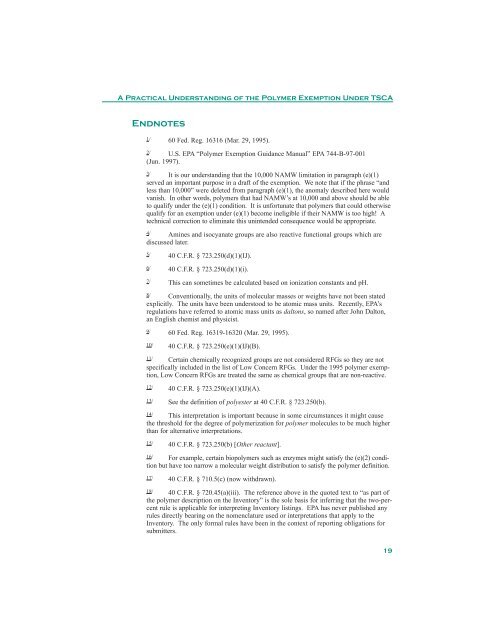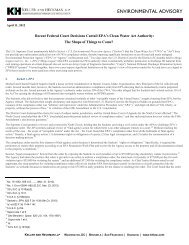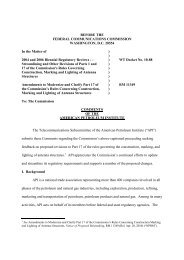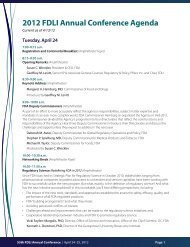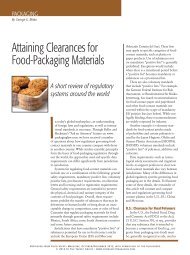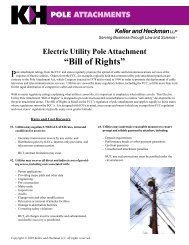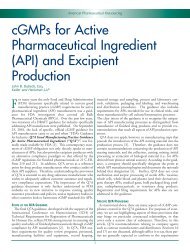A Practical Understanding of the Polymer ... - Keller Heckman
A Practical Understanding of the Polymer ... - Keller Heckman
A Practical Understanding of the Polymer ... - Keller Heckman
You also want an ePaper? Increase the reach of your titles
YUMPU automatically turns print PDFs into web optimized ePapers that Google loves.
A <strong>Practical</strong> <strong>Understanding</strong> <strong>of</strong> <strong>the</strong> <strong>Polymer</strong> Exemption Under TSCA<br />
Endnotes<br />
1/ 60 Fed. Reg. 16316 (Mar. 29, 1995).<br />
2/ U.S. EPA “<strong>Polymer</strong> Exemption Guidance Manual” EPA 744-B-97-001<br />
(Jun. 1997).<br />
3/ It is our understanding that <strong>the</strong> 10,000 NAMW limitation in paragraph (e)(1)<br />
served an important purpose in a draft <strong>of</strong> <strong>the</strong> exemption. We note that if <strong>the</strong> phrase “and<br />
less than 10,000” were deleted from paragraph (e)(1), <strong>the</strong> anomaly described here would<br />
vanish. In o<strong>the</strong>r words, polymers that had NAMW’s at 10,000 and above should be able<br />
to qualify under <strong>the</strong> (e)(1) condition. It is unfortunate that polymers that could o<strong>the</strong>rwise<br />
qualify for an exemption under (e)(1) become ineligible if <strong>the</strong>ir NAMW is too high! A<br />
technical correction to eliminate this unintended consequence would be appropriate.<br />
4/ Amines and isocyanate groups are also reactive functional groups which are<br />
discussed later.<br />
5/ 40 C.F.R. § 723.250(d)(1)(IJ).<br />
6/ 40 C.F.R. § 723.250(d)(1)(i).<br />
7/ This can sometimes be calculated based on ionization constants and pH.<br />
8/ Conventionally, <strong>the</strong> units <strong>of</strong> molecular masses or weights have not been stated<br />
explicitly. The units have been understood to be atomic mass units. Recently, EPA’s<br />
regulations have referred to atomic mass units as daltons, so named after John Dalton,<br />
an English chemist and physicist.<br />
9/ 60 Fed. Reg. 16319-16320 (Mar. 29, 1995).<br />
10/ 40 C.F.R. § 723.250(e)(1)(IJ)(B).<br />
11/ Certain chemically recognized groups are not considered RFGs so <strong>the</strong>y are not<br />
specifically included in <strong>the</strong> list <strong>of</strong> Low Concern RFGs. Under <strong>the</strong> 1995 polymer exemption,<br />
Low Concern RFGs are treated <strong>the</strong> same as chemical groups that are non-reactive.<br />
12/ 40 C.F.R. § 723.250(e)(1)(IJ)(A).<br />
13/ See <strong>the</strong> definition <strong>of</strong> polyester at 40 C.F.R. § 723.250(b).<br />
14/ This interpretation is important because in some circumstances it might cause<br />
<strong>the</strong> threshold for <strong>the</strong> degree <strong>of</strong> polymerization for polymer molecules to be much higher<br />
than for alternative interpretations.<br />
15/ 40 C.F.R. § 723.250(b) [O<strong>the</strong>r reactant].<br />
16/ For example, certain biopolymers such as enzymes might satisfy <strong>the</strong> (e)(2) condition<br />
but have too narrow a molecular weight distribution to satisfy <strong>the</strong> polymer definition.<br />
17/ 40 C.F.R. § 710.5(c) (now withdrawn).<br />
18/ 40 C.F.R. § 720.45(a)(iii). The reference above in <strong>the</strong> quoted text to “as part <strong>of</strong><br />
<strong>the</strong> polymer description on <strong>the</strong> Inventory” is <strong>the</strong> sole basis for inferring that <strong>the</strong> two-percent<br />
rule is applicable for interpreting Inventory listings. EPA has never published any<br />
rules directly bearing on <strong>the</strong> nomenclature used or interpretations that apply to <strong>the</strong><br />
Inventory. The only formal rules have been in <strong>the</strong> context <strong>of</strong> reporting obligations for<br />
submitters.<br />
19


